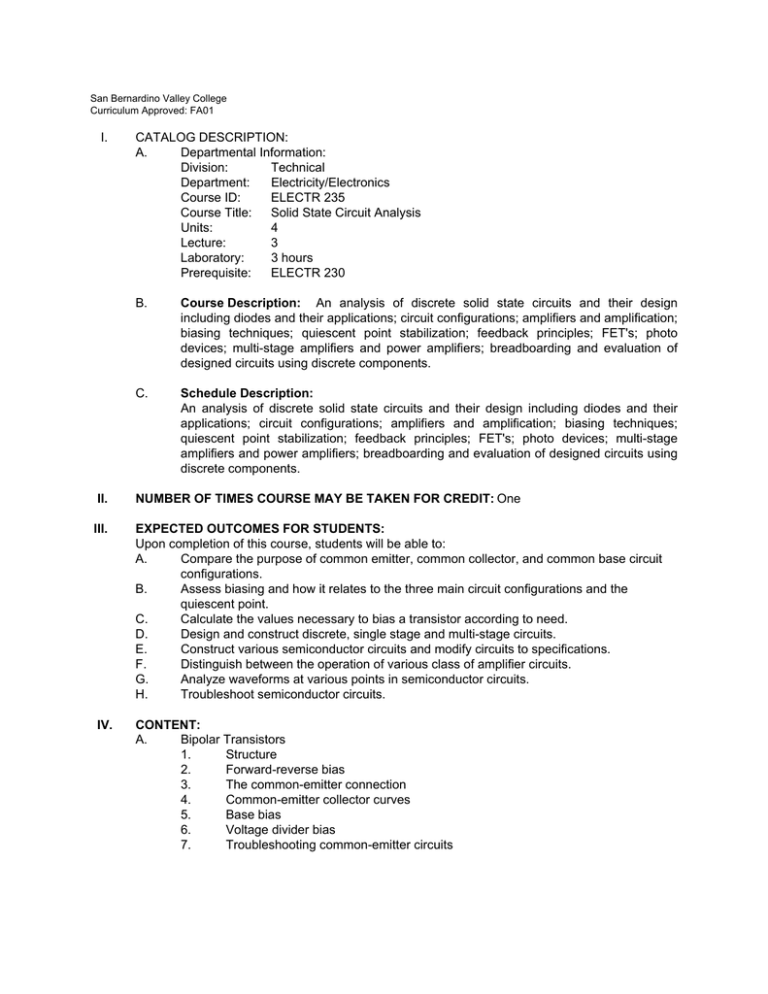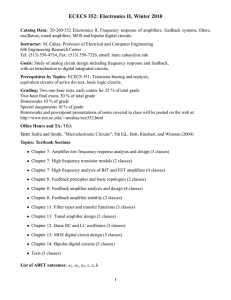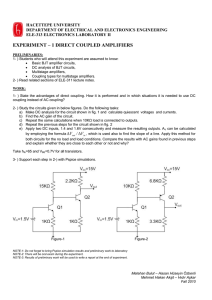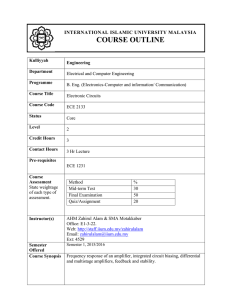ELECTR 235
advertisement

San Bernardino Valley College Curriculum Approved: FA01 I. CATALOG DESCRIPTION: A. Departmental Information: Division: Technical Department: Electricity/Electronics Course ID: ELECTR 235 Course Title: Solid State Circuit Analysis Units: 4 Lecture: 3 Laboratory: 3 hours Prerequisite: ELECTR 230 B. Course Description: An analysis of discrete solid state circuits and their design including diodes and their applications; circuit configurations; amplifiers and amplification; biasing techniques; quiescent point stabilization; feedback principles; FET's; photo devices; multi-stage amplifiers and power amplifiers; breadboarding and evaluation of designed circuits using discrete components. C. Schedule Description: An analysis of discrete solid state circuits and their design including diodes and their applications; circuit configurations; amplifiers and amplification; biasing techniques; quiescent point stabilization; feedback principles; FET's; photo devices; multi-stage amplifiers and power amplifiers; breadboarding and evaluation of designed circuits using discrete components. II. NUMBER OF TIMES COURSE MAY BE TAKEN FOR CREDIT: One III. EXPECTED OUTCOMES FOR STUDENTS: Upon completion of this course, students will be able to: A. Compare the purpose of common emitter, common collector, and common base circuit configurations. B. Assess biasing and how it relates to the three main circuit configurations and the quiescent point. C. Calculate the values necessary to bias a transistor according to need. D. Design and construct discrete, single stage and multi-stage circuits. E. Construct various semiconductor circuits and modify circuits to specifications. F. Distinguish between the operation of various class of amplifier circuits. G. Analyze waveforms at various points in semiconductor circuits. H. Troubleshoot semiconductor circuits. IV. CONTENT: A. Bipolar Transistors 1. Structure 2. Forward-reverse bias 3. The common-emitter connection 4. Common-emitter collector curves 5. Base bias 6. Voltage divider bias 7. Troubleshooting common-emitter circuits San Bernardino Valley College Curriculum Approved: FA01 B. C. D. E. F. G. H. V. Common-Emitter Approximations 1. Superposition theorem 2. AC resistance of a diode 3. Analyzing a common-emitter amplifier 4. Swamping the emitter diode 5. Cascaded stages Common-Collector Approximations 1. The common-collector configuration 2. Input impedance 3. Power gain 4. Source impedance 5. Output impedance 6. Using an emitter-follower 7. The Darlington pair 8. The zener follower Common-Base Approximations 1. Common-base curves 2. The ideal common-base transistor 3. The common-base amplifier Class A Power Amplifiers 1. The AC load line 2. AC compliance 3. Centering the Q point on the DC load line 4. Centering the Q point on the AC load line 5. Power formulas 6. Transistor power rating Other Power Amplifiers 1. Classes of operation 2. Class “B” push-pull amplifier 3. Power formulas 4. Voltage divider bias 5. Cascaded stages 6. Tuned class “C” amplifier 7. Switching operation JFETS 1. Basic ideas 2. Current source bias 3. AC model of a JFET 4. JFET amplifier configurations MOSFETS 1. Depletion-type MOSFET 2. Enhancement-type MOSFET 3. Enhancement-type MOSFET applications METHODS OF INSTRUCTION: Methods of instruction will vary from instructor to instructor but may include: A. Lectures and discussions about circuit purpose, circuit selection, component biasing, circuit configuration, circuit “class”, and troubleshooting. B. Lectures and discussions are complemented with practical laboratory projects emphasizing circuit parameters. San Bernardino Valley College Curriculum Approved: FA01 C. D. Dynamics are accented with the use of videos and film strips. Homework is assigned to promote expertise, vocabulary and writing skills. VI. TYPICAL ASSIGNMENTS: A. Use a calculator to solve biasing network problems. B. Complete a variational analysis of various amplifier circuits. C. Written homework assigned each week from the questions and problems in each chapter. Typical Question: Explain biasing and how it relates to the three main circuit configurations and the quiescent point. VII. EVALUATION: A. Methods of evaluation will vary from instructor to instructor but may include: 1. Quizzes 2. End-of-chapter homework problems 3. End-of-chapter tests 4. Final exam Typical Question: Explain the operation of various classes of amplifier circuits. B. Frequency of evaluation will vary from instructor to instructor but may include: 1. Periodic feedback based on chapter problems 2. Six (6) chapter exams 3. Eleven (11) practical labs with written conclusions graded on content and spelling 4. One (1) comprehensive final exam VIII. TYPICAL TEXT(S): Denton, J., Electronic Devices and Circuits, Prentice Hall, New Jersey, 2001 Paynter, R., Introductory Electronic Devices and Circuits, Prentice Hall, New Jersey, 2000 Malvano, A. P., Semiconductor Circuit Approximations, An Introduction To Transistors And th Integrated Circuits, 4 Edition, Glenco, New York, 1993 IX. OTHER SUPPLIES REQUIRED OF STUDENTS: Scientific calculator.





